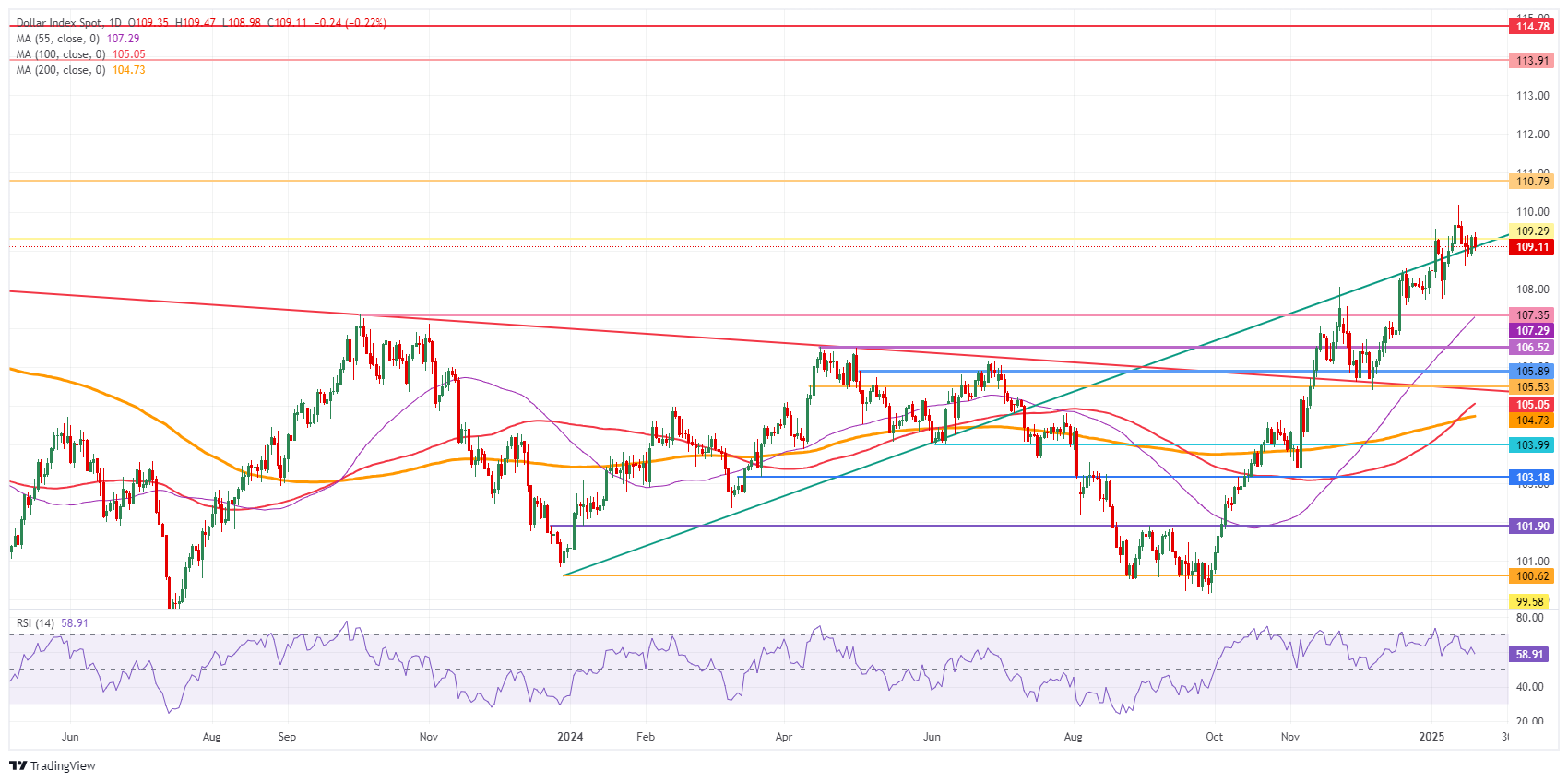Metatitle: The US Dollar is in choppy trading ahead of Preside...
- The US Dollar is in choppy trading ahead of President-elect Donald Trump’s inauguration.
- Trading floors in the US will remain closed due to Martin Luther King’s Day.
- The US Dollar Index (DXY) stays afloat near 109.00 with uncertainty ahead.
The US Dollar Index (DXY), which tracks the Greenback’s value against six major currencies, trades roughly flat and holds near 109.00 on Monday ahead of President-elect Donald Trump’s inauguration as the 47th President of the United States (US). Several asset classes in the US will remain closed, such as the Wall Street trading floor and US bond trading, in observance of Martin Luther King’s Day. This means erratic moves could occur in a market with thin liquidity.
All eyes will be on the aftermath of the inauguration, where President-elect Donald Trump has already confirmed in a rally on Sunday that a whole battery of new measures and executive orders will be issued. The main ones are, of course, more tariffs, mass deportation starting in Chicago, and issuing state of emergencies for energy and border security, Bloomberg reported. By issuing those last two, the upcoming President Trump can give the green light for massive drilling and mass deporting illegal immigrants without having to pass through Congress and the House of Representatives.
Daily digest market movers: All eyes on Trump’s first moves
- At 17:00 GMT, the Presidential Inauguration will take place, with Donald Trump being sworn in as the 47th President of the United States.
- Due to Martin Luther King’s Day, several trading floors in the US will remain closed throughout the day.
- Equities are off to a positive start on the day, with green numbers from Asia over Europe and US equity futures.
- The CME FedWatch tool projects a 55.6% chance that interest rates will remain unchanged at current levels in the May meeting, suggesting a rate cut in June. Expectations are that the Federal Reserve (Fed) will remain data-dependent with uncertainties that could influence inflation during President-elect Donald Trump’s term.
- The US 10-year yield is trading around 4.627% and will remain at that level this Monday, as bond trading in the US is closed due to the Martin Luther King’s bank holiday.
US Dollar Index Technical Analysis: No plan from here
The US Dollar Index (DXY) sees a split division between bears and bulls. The new Trump administration is set to unleash a large number of executive orders, making it hard for markets to assess the impact. With several topics being addressed and communicated in advance, it looks like markets have already priced in a fair bit of inflationary pressure from Trumponomics. The question now will be if the markets are correct and if the DXY index will ease further from current levels on the back of an overestimation of the actual impact of the measures being imposed.
On the upside, the 110.00 psychological level remains the key resistance to beat. Further up, the next big upside level to hit before advancing any further remains at 110.79 (September 7, 2022, high). Once beyond there, it is quite a stretch to 113.91, a double top from October 2022.
On the downside, the DXY is trading alongside the ascending trend line coming from December 2023, which currently comes in around 109.10 as nearby support. In case of more downside, the next support is 107.35 (October 3, 2023, high). Further down, the 55-day Simple Moving Average (SMA) at 107.29 should catch any falling knives.

US Dollar Index: Daily Chart
US Dollar FAQs
The US Dollar (USD) is the official currency of the United States of America, and the ‘de facto’ currency of a significant number of other countries where it is found in circulation alongside local notes. It is the most heavily traded currency in the world, accounting for over 88% of all global foreign exchange turnover, or an average of $6.6 trillion in transactions per day, according to data from 2022. Following the second world war, the USD took over from the British Pound as the world’s reserve currency. For most of its history, the US Dollar was backed by Gold, until the Bretton Woods Agreement in 1971 when the Gold Standard went away.
The most important single factor impacting on the value of the US Dollar is monetary policy, which is shaped by the Federal Reserve (Fed). The Fed has two mandates: to achieve price stability (control inflation) and foster full employment. Its primary tool to achieve these two goals is by adjusting interest rates. When prices are rising too quickly and inflation is above the Fed’s 2% target, the Fed will raise rates, which helps the USD value. When inflation falls below 2% or the Unemployment Rate is too high, the Fed may lower interest rates, which weighs on the Greenback.
In extreme situations, the Federal Reserve can also print more Dollars and enact quantitative easing (QE). QE is the process by which the Fed substantially increases the flow of credit in a stuck financial system. It is a non-standard policy measure used when credit has dried up because banks will not lend to each other (out of the fear of counterparty default). It is a last resort when simply lowering interest rates is unlikely to achieve the necessary result. It was the Fed’s weapon of choice to combat the credit crunch that occurred during the Great Financial Crisis in 2008. It involves the Fed printing more Dollars and using them to buy US government bonds predominantly from financial institutions. QE usually leads to a weaker US Dollar.
Quantitative tightening (QT) is the reverse process whereby the Federal Reserve stops buying bonds from financial institutions and does not reinvest the principal from the bonds it holds maturing in new purchases. It is usually positive for the US Dollar.
